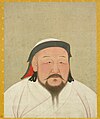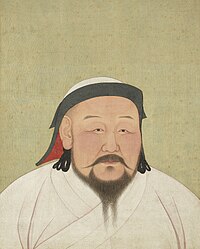Tugna:YuanEmperorAlbumKhubilaiPortrait.jpg
Apparence

Tiddi n azaraskan agi : 480 × 599 iferdisen n tugna. Tibuda nniḍen : 192 × 240 iferdisen n tugna | 385 × 480 iferdisen n tugna | 616 × 768 iferdisen n tugna | 821 × 1 024 iferdisen n tugna | 1 642 × 2 048 iferdisen n tugna | 3 221 × 4 018 iferdisen n tugna.
Afaylu aneṣli (3 221 × 4 018 pixel, tiddi n ufaylu: 13,02 MB/MO, anaw n MIME: image/jpeg)
Amazray n ufaylu
Senned ɣef yiwen azmez d usrag iwakken ad ẓṛeḍ afaylu aken yella deg imir nni.
| Azemz/Ssaɛa | Aqmamaḍ | Iseggiwen | Amseqdac | Awennit | |
|---|---|---|---|---|---|
| Lux a | 21 Duǧember 2022 à 11:19 |  | 3 221 × 4 018 (13,02 MB/MO) | Kcx36 | higher resolution |
| 24 Fuṛaṛ 2021 à 12:46 |  | 2 678 × 3 200 (967 KB/KO) | CAPTAIN MEDUSA | higher res | |
| 13 Tuber 2016 à 00:03 |  | 1 339 × 1 600 (1,54 MB/MO) | Eugene a | True color | |
| 7 Duǧember 2010 à 18:04 |  | 864 × 1 077 (123 KB/KO) | Eugene a | Best version | |
| 25 Wamber 2010 à 18:21 |  | 480 × 618 (120 KB/KO) | Dirrival | a better version | |
| 30 Ctember 2010 à 04:43 |  | 517 × 640 (68 KB/KO) | Wmpearl | ||
| 28 Mayyu 2008 à 14:03 |  | 877 × 1 103 (161 KB/KO) | Yaan | == Summary == {{Information |Description = Shizu, better known as Khubilai. Portrait cropped out of a page from an album depicting several Yuan emperors (Yuandai di banshenxiang), now located in the National Palace Museum in Taipei (inv. nr. zhonghua 0003 |
Aseqdec n ufaylu
Asebter agi teseqdac afaylu agi :
Aseqdec n ufaylu amatu
Iwikiyen-agi-nniḍen seqdacen afaylu-agi:
- Aseqdec ɣef af.wikipedia.org
- Aseqdec ɣef als.wikipedia.org
- Aseqdec ɣef ang.wikipedia.org
- Aseqdec ɣef an.wikipedia.org
- Aseqdec ɣef ar.wikipedia.org
- قوبلاي خان
- ويكيبيديا:في هذا اليوم/5 مايو
- إمبراطورية المغول
- بوابة:أعلام/صورة مختارة/أرشيف
- ويكيبيديا:صور مختارة/فنون/منمنمات
- بوابة:الإمبراطورية المغولية/شخصية مختارة
- بوابة:الإمبراطورية المغولية/شخصية مختارة/أرشيف
- بوابة:الإمبراطورية المغولية/شخصية مختارة/1
- ويكيبيديا:في هذا اليوم/مايو
- فن صيني
- ويكيبيديا:ترشيحات الصور المختارة/قوبلاي خان
- ويكيبيديا:صورة اليوم المختارة/مارس 2021
- قالب:صورة اليوم المختارة/2021-03-29
- بوابة:أعلام/صورة مختارة/42
- الحرب الأهلية التولوية
- ويكيبيديا:صورة اليوم المختارة/سبتمبر 2022
- قالب:صورة اليوم المختارة/2022-09-23
- Aseqdec ɣef ar.wikinews.org
- Aseqdec ɣef arz.wikipedia.org
- Aseqdec ɣef ast.wikipedia.org
- Aseqdec ɣef azb.wikipedia.org
- Aseqdec ɣef az.wikipedia.org
- Aseqdec ɣef ba.wikipedia.org
Wali l’utilisation globale n ufaylu-agi.



